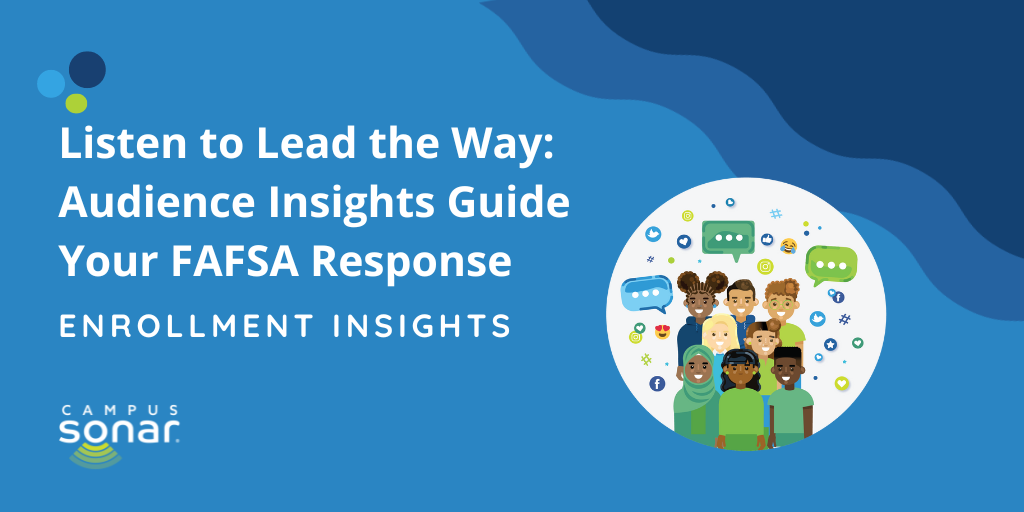Listen to Lead the Way: Audience Insights Guide Your FAFSA Response

It’s no secret by now that the redesign and relaunch of the FAFSA form at the federal level has caused stress and confusion for higher ed leaders and college-going families alike. Staff and administrators are navigating frequent updates and shifting processes and timelines; and further uncertainty about aid and finances has added to the worries prospective students already feel about affording a degree. (Our national industry listening continues to reveal scholarships and financial aid as top topics discussed online in terms of the college decision-making process.)
At Campus Sonar, our mission is to restore and grow the public’s trust in higher education. Even (and perhaps, most especially) in times like these, it’s possible to take a human-centered approach that can demonstrate empathy, build confidence, and differentiate your institution.
Start By Listening
If you’re looking to understand student and family feelings on this topic, forums are the place to go. With a higher degree of anonymity, they’re more likely to speak candidly in sharing their questions and frustrations in these spaces. Go beyond your own campus channels, as posters often talking in more general threads focused on applying to college and financial aid.
In researching recent conversations, we see frustration directed more at the Department of Education than at individual campuses. Admits are paying deposits at multiple institutions to buy themselves more time while they wait for awards, while some parents are feeling the financial pressure around this tactic. There's confusion and anxiety about what the simplified FAFSA process means for families with multiple children in college, a factor for both new and continuing students. On top of this, families are stressed by the increased campus communications about action steps, like signing up for orientation, registering for classes, and selecting priority housing, all while waiting to see if the award package will allow their student to comfortably attend school.
Although these conversations may be happening outside of the main channels for your institution, that doesn’t mean they don’t affect your future classes and enrollment planning. Going beyond direct tags and mentions to understand how students and families talk and influence each other’s strategies can inform the ways you develop plans and communicate with your own audience.
Create Empathetic and Transparent Communication Plans
In times of crisis, it’s critical to equip front-life staff and communicators with the updates they need to respond in real-time to questions and concerns. Who is guiding the FAFSA response on campus? Where should questions be directed? Can Q&A replies be shared with social media managers, admissions counselors, advisors, and others who are fielding questions? What about a landing page that can be quickly shared and updated as processes and news shifts? Being proactive not only assuages the concerns of your audiences; it goes a long way in helping campus staff feel empowered and supported.
Where possible, consider how your campus can offer admitted students and families additional breathing room. While orientation dates are set and course registration plans arranged, are there ways you can extend the timeline so those who need additional time for award consideration can do so without feeling like an outlier? These delays will already disproportionately affect those who may be navigating barriers. How can you adjust these hurdles so they feel included and welcomed in your process? Consider how you can adapt these core campus milestones in a way that acknowledges the procedural change without making students and families feel like a burden.
Above all, use language people understand. Like many aspects of higher education, financial aid can feel a bit like alphabet soup with the FAFSA, EFC, SAI, NPC, and so on. Consider what your audience really needs and target messages they’ll understand.
Keep Iterating
Listen, communicate, repeat. It’s more crucial than ever to approach our systems, processes, and messages—both for internal and external audiences—with their needs, hopes, fears, and dreams in mind. While it’s helpful to note what other schools are doing, remember to focus on your unique campus population and community, and let them help lead the way forward. When prospective students see themselves in your outreach and actions, you build trust even in the most difficult of scenarios. But first? You have to hold up the mirror, and listen.
